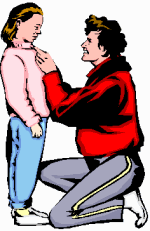|
After reading the following story I was once again
struck by the fact that fire departments have an obligation to do
more than just put out fires. Fire prevention and fire safety instruction
are as much a part of what we do as fire suppression and are maybe
even more important in the long run.
A Flash Fire and Its Longer Aftermath
 "Eight-year-old
Susan and her older brother are playing in their garage. An unsealed
can of gasoline tips over and, an instant later, the pilot light
of the nearby water heater ignites the vapor. In the flash fire
and explosion, Susan's face and arms are badly burned, her dress
set afire. She is rushed to a local emergency room, where she is
treated for shock. Because the burns are extensive and predominantly
third degree (the most severe kind), the doctors arrange for her
admission to a burn center, 100 miles away. "Eight-year-old
Susan and her older brother are playing in their garage. An unsealed
can of gasoline tips over and, an instant later, the pilot light
of the nearby water heater ignites the vapor. In the flash fire
and explosion, Susan's face and arms are badly burned, her dress
set afire. She is rushed to a local emergency room, where she is
treated for shock. Because the burns are extensive and predominantly
third degree (the most severe kind), the doctors arrange for her
admission to a burn center, 100 miles away.
"There, intensive care begins. The wounds are
cleaned and treated with antibacterial agents; intravenous lines
are inserted; and a catheter is placed into the bladder to collect
urine, which serves as a guide to the fluid needs of the body. Nurses
in the intensive care unit keep a close watch, lest she go into
shock or turn blue from smoke inhalation injury. Later she is anesthetized
and wheeled into surgery, where a doctor begins debridement, the
cutting away of burned tissue. The wounds are covered with antibiotic
dressing, and Susan is given penicillin to ward off infection.
"More debridement operations follow. Doctors
and nurses continue to monitor closely Susan's fluid management
and the functioning of her vital organs. On the third day, having
survived the acute phase in which fluid imbalances can be fatal,
Susan is taking fluid by the mouth, and the intravenous lines are
removed. For the first time, she complains of pain from her wounds.
On the seventh day there is a marked change in Susan.
She refuses food, she is truly unruly. But the staff members have
seen this kind of behavior often, for it signals the onset of guilt
or fear of parental reaction about the accident. After conferring
with the staff, Susan's parents discuss the accident, assuring her
they were concerned but not angry. Her mood brightens. Having less
than the normal amount of skin is a depressing condition, and it
is common for patients to be difficult, irascible, or complaining
until the wounds heal or are successfully skin-grafted.
"During the second and third weeks, operations
are performed to remove further dead skin. As so often happens,
the wounds become infected and for a time her life is in jeopardy.
In the fourth week grafting operations begin -- four in all, stage
at 10-day intervals. Between operations, Susan undergoes intensive
physical therapy, since grafted skin tends to contract and hamper
the body's movements. Despite all precautions, contractures of her
neck, right wrist, and right hand begin to develop, drawing her
chin toward her chest, her wrist backward, and her fingers out of
joint. Though Susan is discharged after 80 hospital days, the deformities
already developing grow worse, despite frequent physical therapy
and splinting. She is readmitted twice during the ensuing 4 months
for reconstructive surgery.
"More plastic surgery awaits her. It will never
totally erase the scars. And despite the efforts of the psychiatrist
on the burn center staff, Susan still carries psychological scars."
- from America Burning, The Report of The National
Commission on Fire Prevention and Control.
|

![]()
